The 2021/22 Serie A season has been full of surprises with Napoli and Milan sitting top of the table, still unbeaten after 12 games while seven points clear of the champions Inter, and Juventus struggling in eighth place.
The managerial changes didn’t only affect those teams’ performances, though. Despite not being title contenders, the under the radar Hellas Verona have impressed under their new coach Igor Tudor, who was appointed in September and started his spell with an impressive win over José Mourinho’s Roma.
Arriving from the assistant job at Juventus, Tudor has started to transform Verona and has surprised many of his opponents with his team’s high pressing intensity and attacking flair. While they still have many flaws defensively, their solid attacking performances troubled the leaders Napoli and Milan, while defeating Juventus, Lazio and Roma in Tudor’s first few games in charge, earning them well-deserved respect in the league. Inter were the only top team that achieved a convincing win over Verona.
Unfortunately, the team’s defensive vulnerability often leads to disappointing results, which is the reason why they currently sit 10th, despite being the third most prolific team in terms of goals scored (25).
The new manager, though, shows a glimpse of his potential and is expected to offer a lot more to the team and enhance their performance even more in the next few months. Before Juventus, Tudor managed the Croatian Hajduk Split and failed to bring them back into the top three, but was described as one of the most innovative young coaches who deserves attention and could succeed in the future.
This tactical analysis in the form of a scout report explains Verona’s tactics and examines their performance so far under the new coach.
Formation and starting XI
Verona were previously most frequently set up in a 3-4-2-1 formation, and Tudor didn’t change much about that. He usually favours the back three too and kept the scheme with slight changes to 3-4-3 in some of the games.
The team try to expose the opposition with measured attacking actions and a very distinguished pressing strategy that helps them in avoiding even more defensive errors. Their press intensity is the key to their successful attacking actions, as they don’t usually have more of the ball, but they do recover the ball frequently and take advantage of these situations in attack.
While pressing high and constantly trying to win the ball back brings them a lot of benefits, it also has flaws, as often their over-commitment to it makes it difficult for them to regroup and defend as a unit, should their opponents bypass the pressing structures.
Another weakness of Tudor’s team is their aggressiveness. Their inability to defend in their own half results in committing individual errors and fouls that often give an advantage to their opponents.
Although the starting XI is rather flexible and the manager rotates certain players, there is a core team that get relied on most frequently.
The goal is covered by Lorenzo Montipò, while the centre-backs with the most playing minutes are Nicolò Casale, Koray Günter and Paweł Dawidowicz, who all have a contribution to the build-up play and to retaining possession. Günter’s positioning and anticipation skills are crucial for the team both in and out of possession.
Centrally, Tudor relies on very active wing-backs in the face of Darko Lazović and the experienced Davide Faraoni. They are highly involved in the team’s attacking actions, as Verona usually build up through the flanks and tend to use the wing-backs to drag defenders out, but also cut inside and provide an additional threat.
The situation in central midfield is more uncertain. The players with the most starts under Tudor are Miguel Veloso and Ivan Ilić, as most of the time, one of them gets replaced by Adrien Tameze. Ilić is the most reliable in terms of pass completion and distributing the ball further, although Veloso’s long balls are often very beneficial for the team.
The most frequent starters in attack are Gianluca Caprari, Antonín Barák and Giovanni Simeone as striker, and this has proven to be the most successful partnership in the frontline so far. Simeone is currently the top goalscorer of the team with nine goals, but his fellow attackers split their responsibilities well and provide both direct and indirect threats.
Actions in possession and ball progression
The team sit considerably high in possession with the three defenders moving closer to the central line. The left and right centre-backs would move even further in efforts to overload the opposition half and control the game there, while Günter would orchestrate the play from the back with his accurate passing and positional sense.
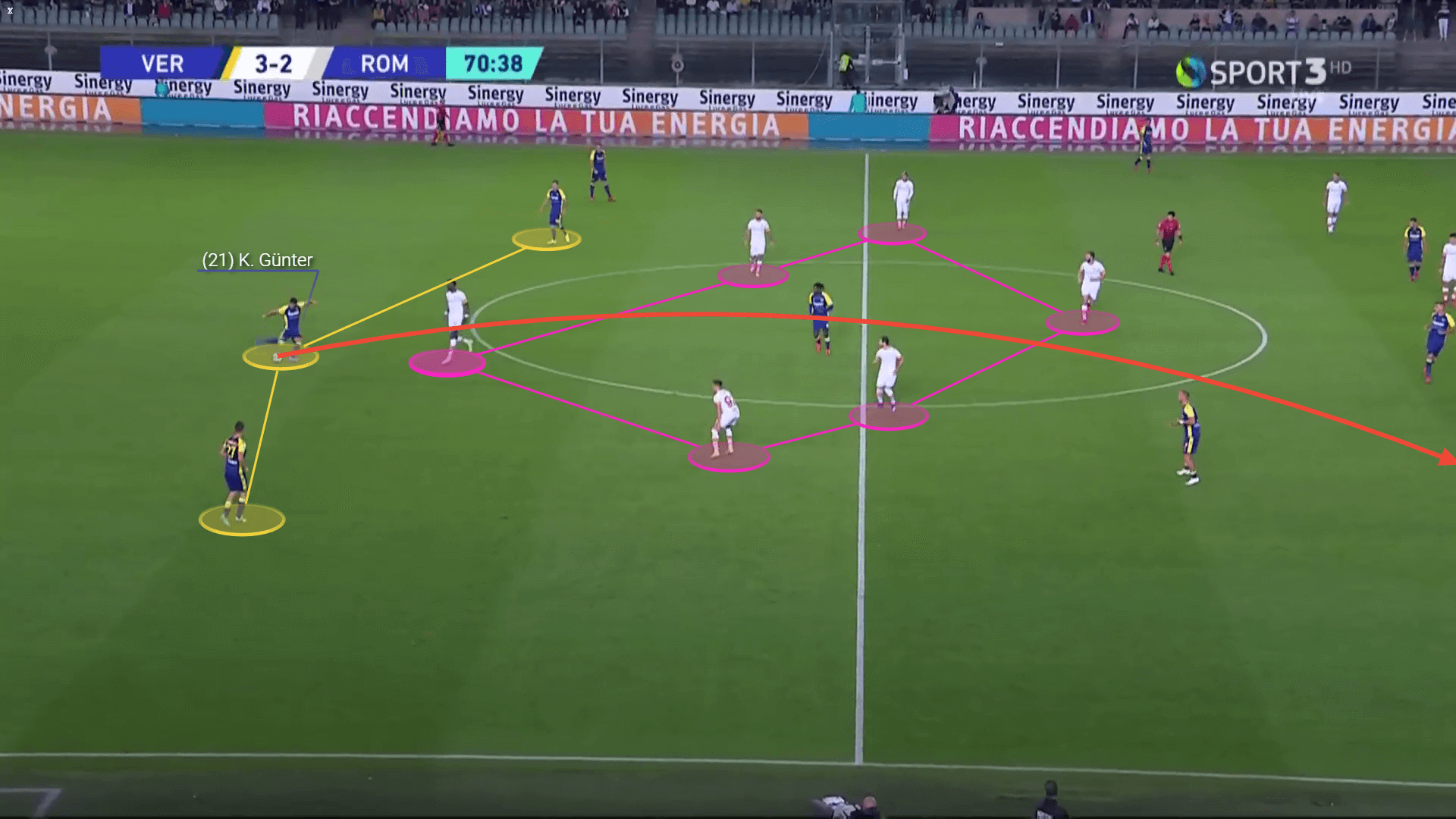
Verona try to stay rather compact, with the forward line dropping deeper and also moving out wide to combine with the advanced defenders and wing-backs. That’s why they prefer to attack through the flanks, where they commit more players and often have a numerical advantage.
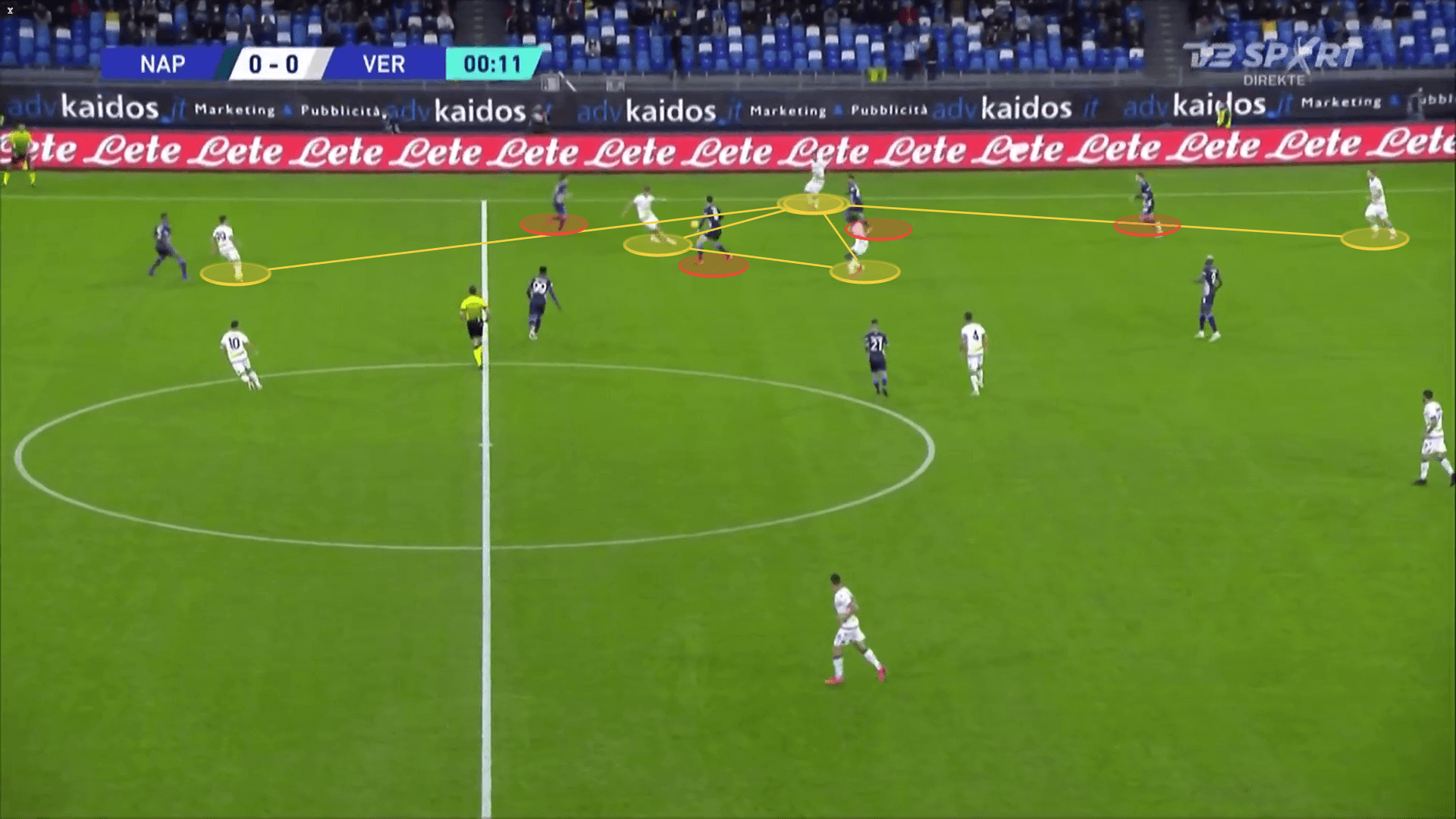
With their link-up-play in the wide areas, they try to engage defenders and open spaces for each other, which helps them in progressing the ball and in breaking through defences. The central midfielders are key for bypassing the press and offering passing options as their positioning and passes allow the team to advance the ball to the final third. They are the connection between the lines and are responsible for releasing the pressure and orchestrating the play forward, supplying the frontline with passes.
They rely on a rather high pass frequency and aim to retain possession with lateral passing and switches of play, although their success rate in terms of offensive duels is unsatisfactory. They often fail to hold onto the ball and give away the possession in midfield, which prevents them from creating more chances.
Despite their tendency to play with width, they often adjust to the opposition’s strategy in-game and try to take advantage of their mistakes. Whenever they are unable to open the passing lanes, they opt for a switch of play in an effort to expose the underloaded areas. The team also go for long balls and more direct play whenever the opposition’s lines are well structured and they are unable to break through.
Final third ventures
The team’s attacking movement is balanced. They don’t overcommit to certain movements and don’t only rely on one method to expose the opposition in the final third. They combine crossing and through balls while also relying on the wingers’ smart passing and movement. They certainly rely mostly on individual skill.
Verona try to break through defences with a lot of movement and overloading the final third. They tend to attack through the wings and then move the ball centrally, relying on short pass combinations. On the flanks, they rely on overlapping and underlapping runs, with all lines involved. Apart from the wide players, the centre midfielders’ support is crucial as they act as passing outlets and support the link-up-play so the team can advance and disposition defenders.
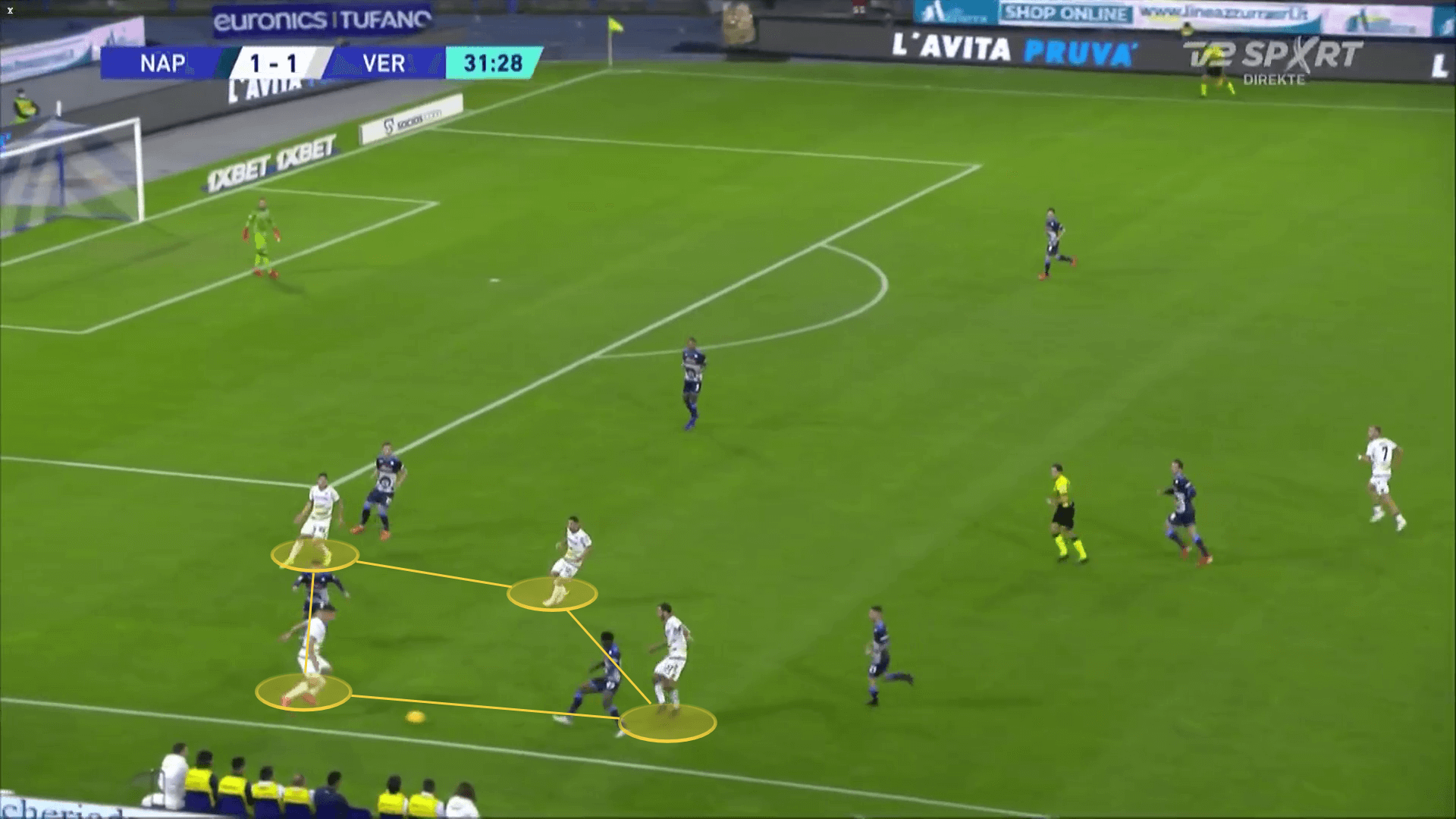
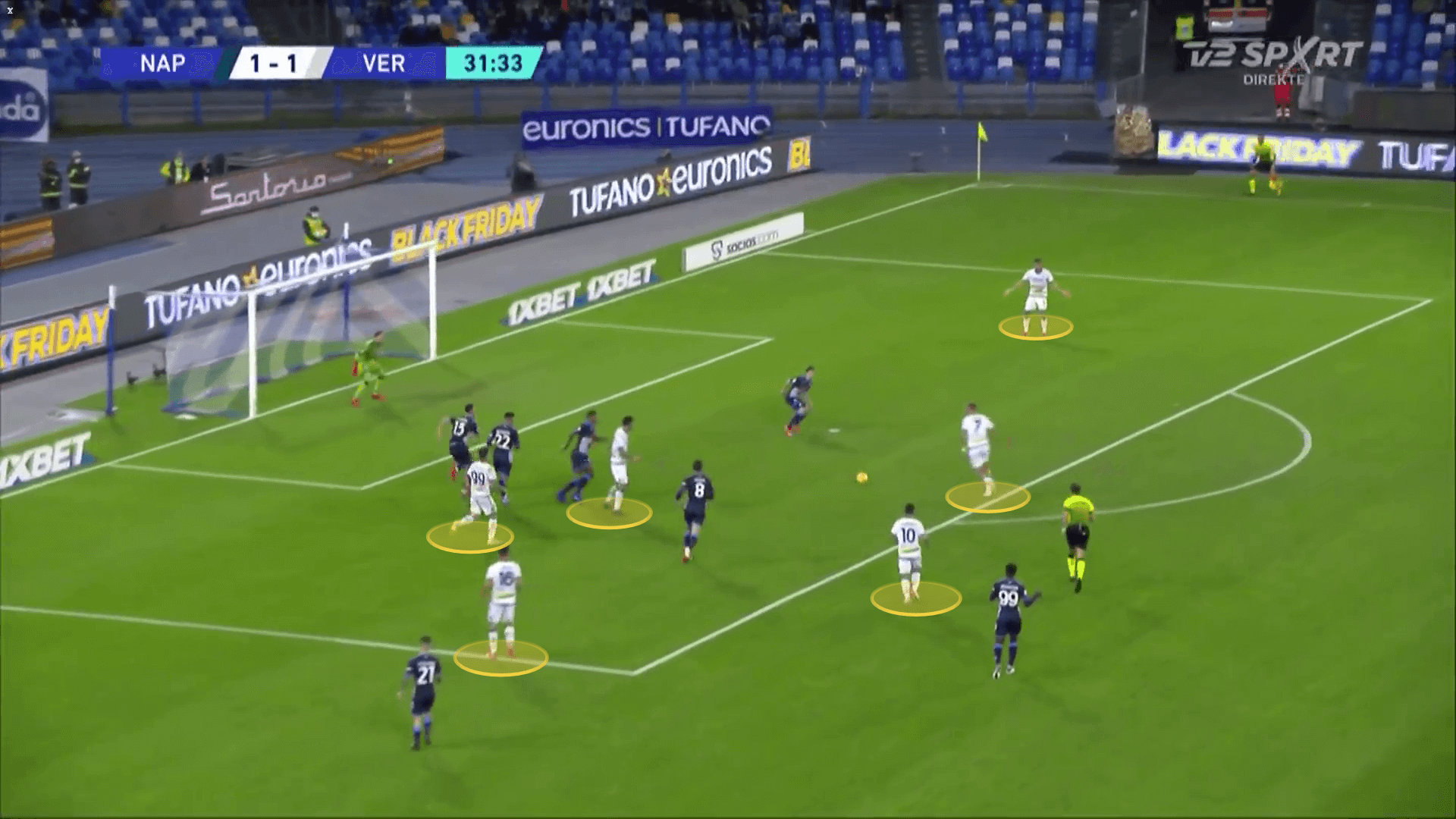
The Mastiffs also often rely on creating chances from outside the box. They take advantage even of the moments when the opposition defend deep and have limited the spaces between the lines. Whenever they are unable to open the channels and deliver the ball to the box, they shoot from distance. They turn being forced to shoot from outside the box into their advantage and another way to catch the opposition off-guard.
The wingers successfully provide both a direct threat and also support their teammates’ movement and create chances for them. They split their responsibilities well and contribute to increasing the efficiency in front of the goal. The wing-backs, though, have similar responsibilities. Their contribution to the attacking actions is key as they cut inside to create overloads in the box and are often in good positions to score. Verona’s performance upfront is well measured. They don’t overproduce shots and don’t like to throw all of their efforts to waste. Instead, they rely on high shot accuracy (second-best in the league). That’s how they have exceeded their xG of 16.18 and have scored 25 goals so far. The team’s movement in and around the box allows them to shoot from quality positions.
Defensive performance
Verona struggle in many aspects, defensively. One of their biggest flaws is their inability to keep possession of the ball. They are among the top three teams in the league that lose the ball most frequently on average per 90. Their 96.41 losses per game are often in dangerous areas and result in the opposition creating goalscoring chances. Many individual errors in the box have resulted in them conceding shots and, respectively, goals. As mentioned, they have difficulties in regrouping and adjusting their marking strategy in-game, which leads to giving their opponents more space to exploit.
Their aggressiveness and unmeasured actions also cause a lot of trouble at the back as they often commit fouls and give away free-kicks around the box, making it even more difficult to defend as they struggle in defending set-pieces. Only Torino’s players commit more fouls per 90 (17.74) than Verona (14.6).
The team have so far conceded five goals from set-plays, along with two penalties. They are often a victim of individual errors and failing to mark the opposing players properly. They easily get distracted by their movement and dragged out of position. Their lack of anticipation skills makes it very difficult to defend against long shots and against through ball attacks as they fail in covering depth which leaves gaps for the opposition. They are also prone to making individual mistakes under pressure which can result in scoring own goals.
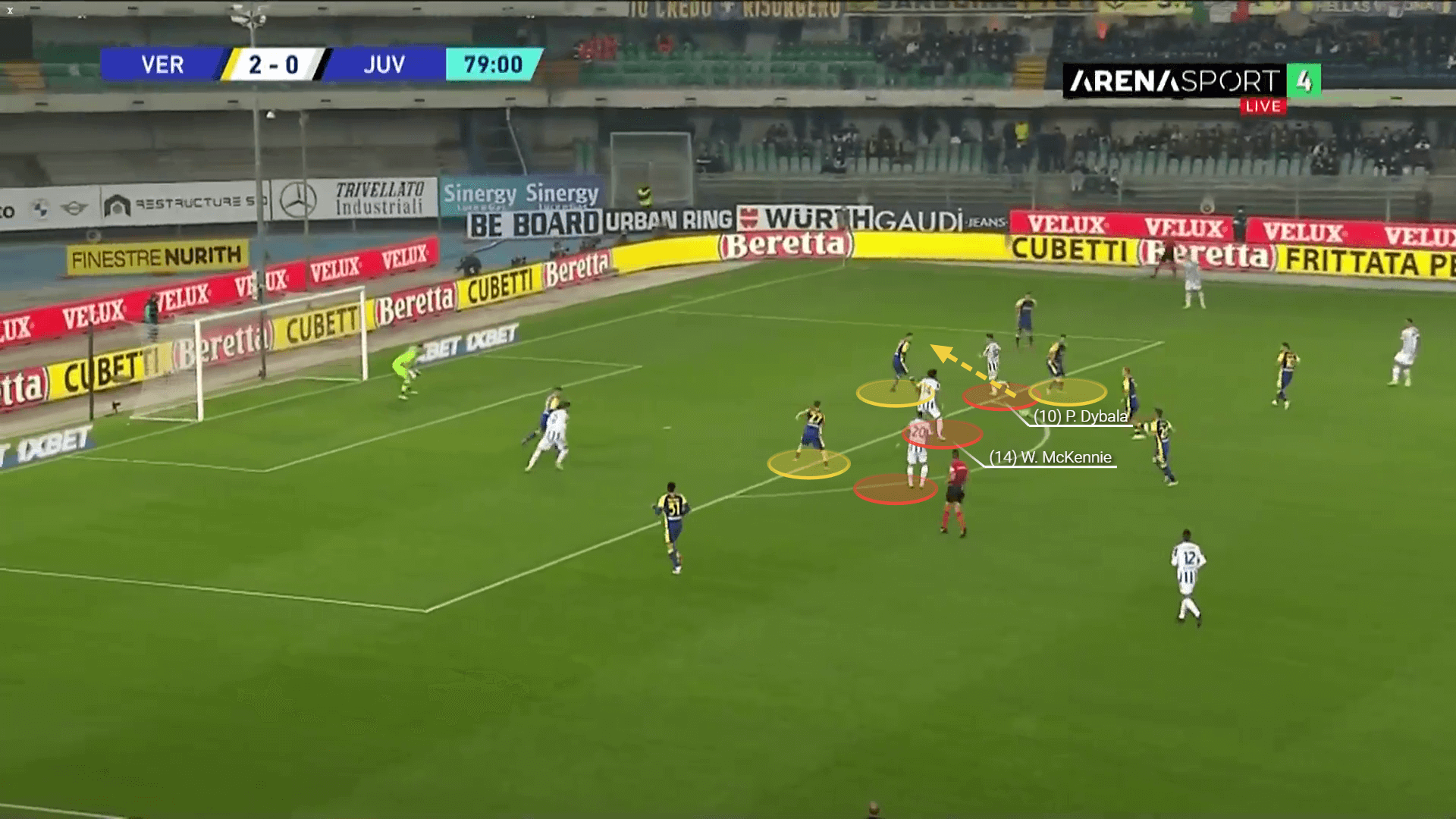
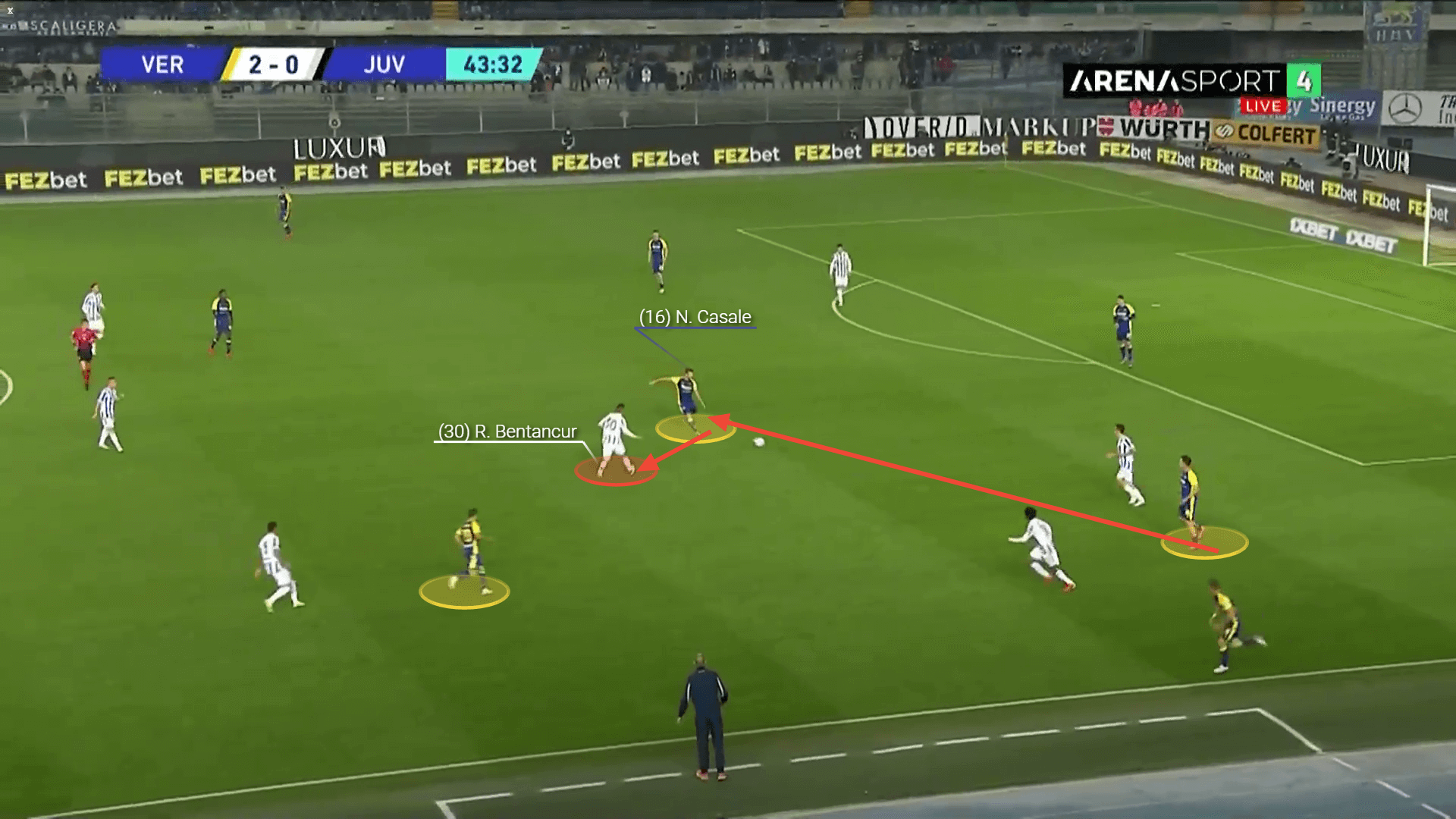
Their biggest strength, defensively, is their pressing strategy. The team usually opt for intense pressing and like to trouble their opponents’ build-up from the back. That is when Tudor’s side are most successful. Their PPDA rate of 9.62 places them fourth in the league in terms of high press intensity. While they lose the ball often, they are also proficient in stealing it from the opposition and creating chances after that.
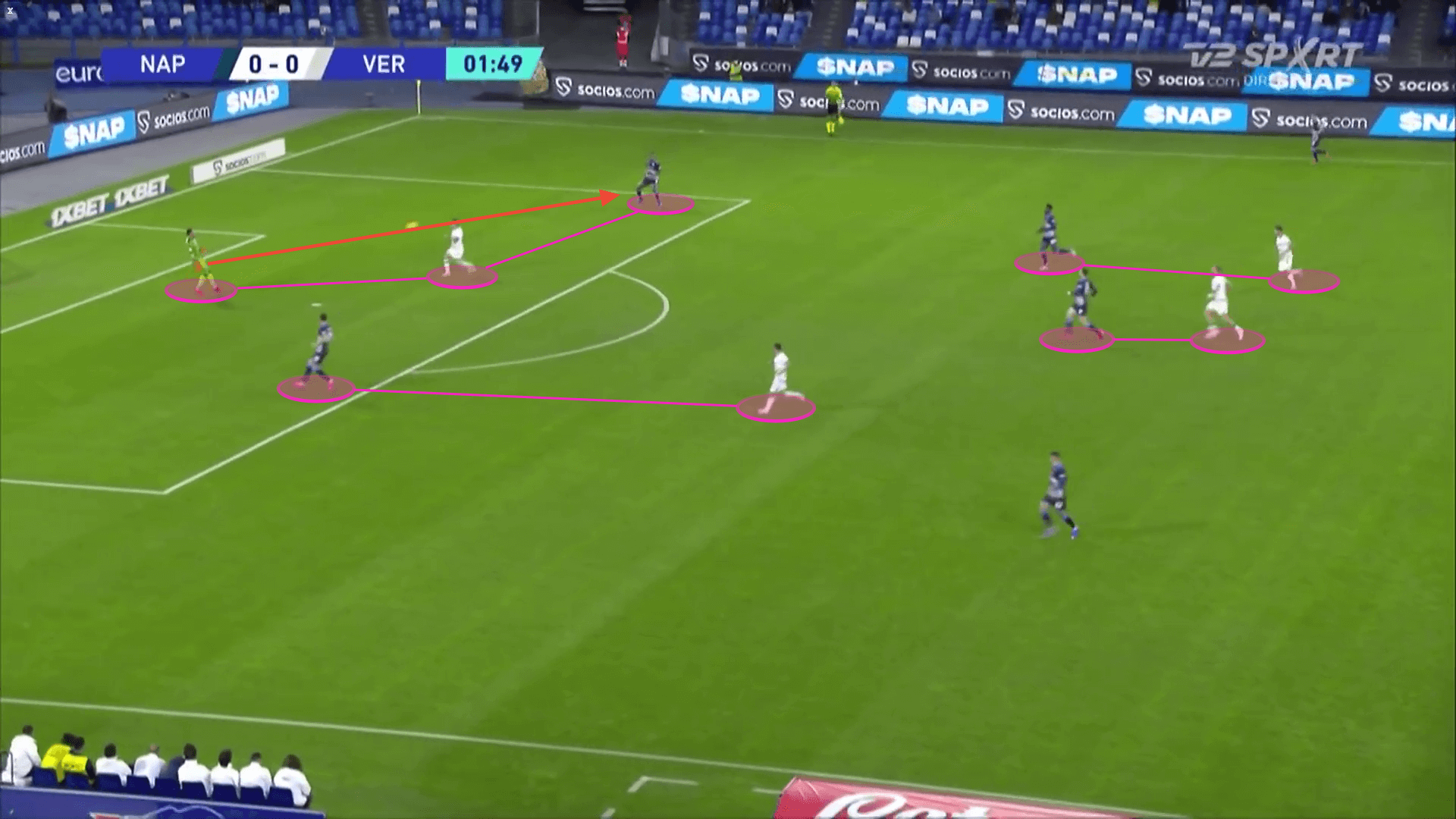
They do opt for high press, but they are most successful in recovering the ball in midfield and then spreading it out in attack. They are most efficient in winning the ball through ground duels, although they also often use their positioning and are successful in the air.
Conclusion
Igor Tudor hasn’t had much time to fully transform Hellas Verona but he’s had an immediate impact on their style of play and performance. As our analysis showed, with measured attacking actions and smart pressing, they managed to outplay big opponents and show character despite their defensive fragilities.
The Croatian coach has to bring balance in their performance and improve their defensive reactions in order for the team to get better results and move up the table. With their consistency in attack, they only need an improved defensive strategy to play on their potential.






Comments